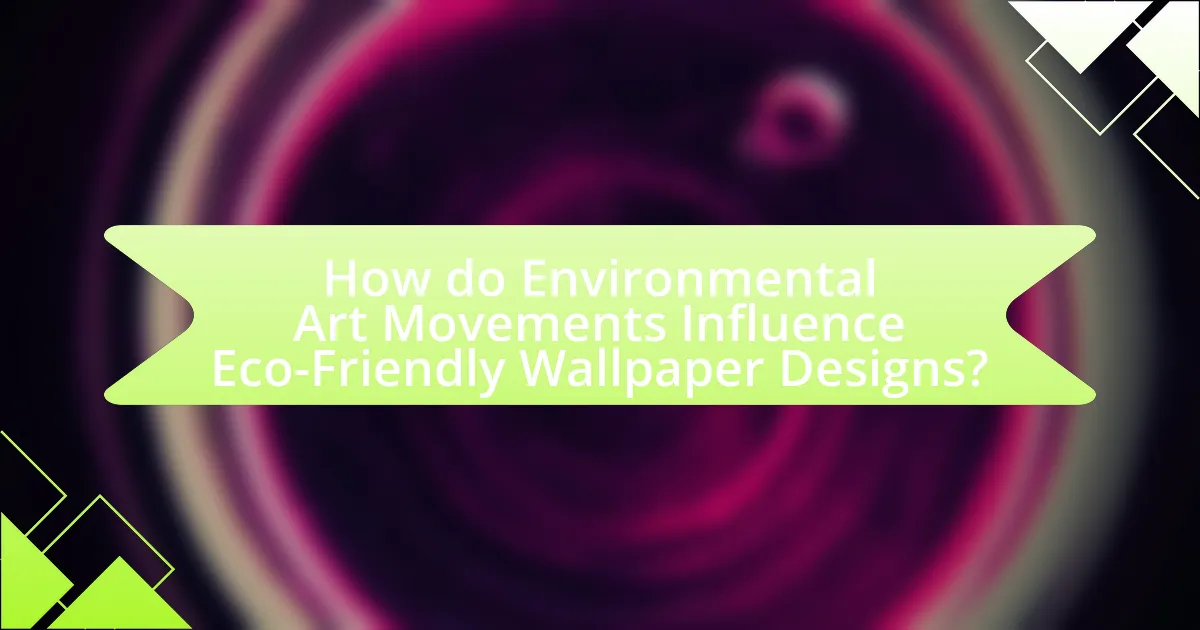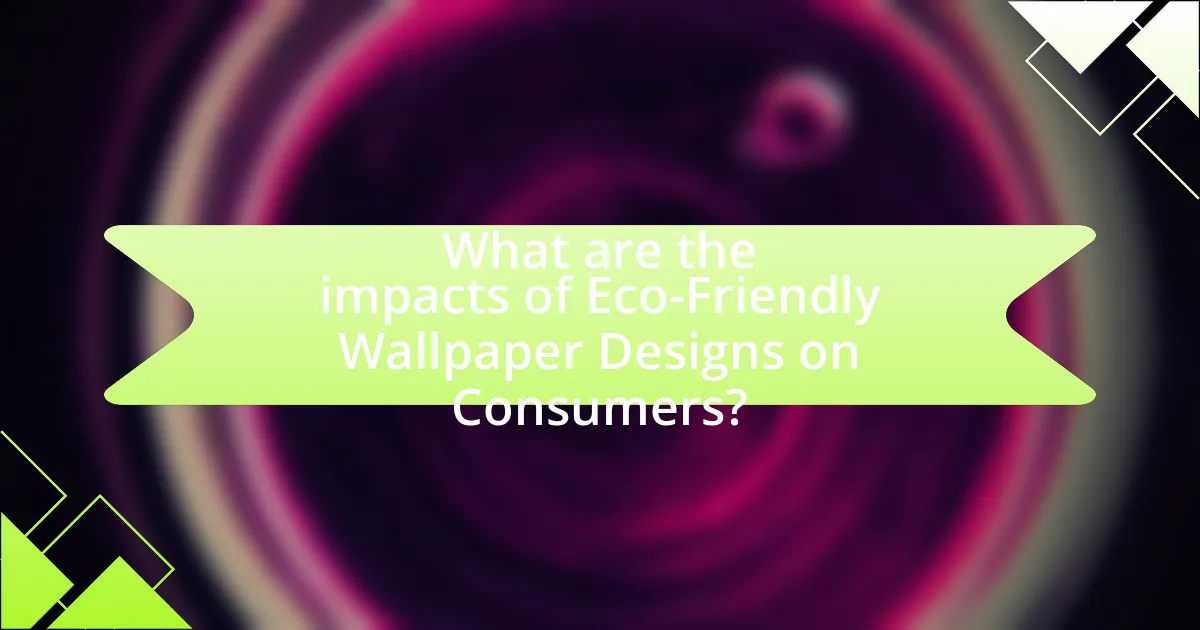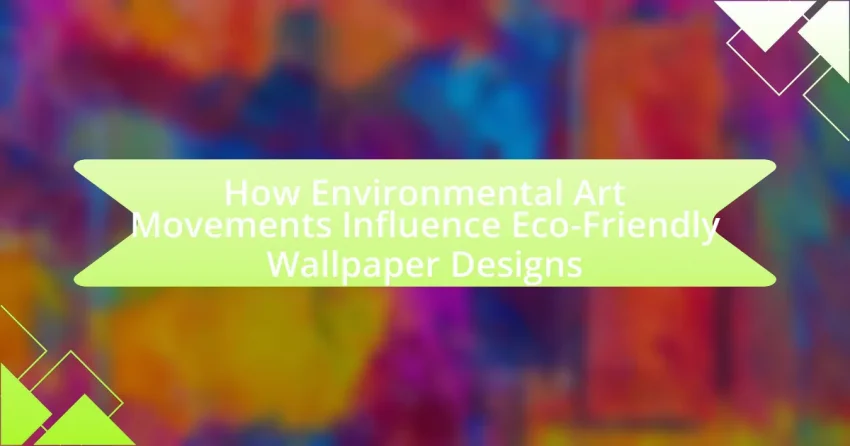Environmental art movements, such as Land Art and Eco-Art, play a crucial role in shaping eco-friendly wallpaper designs by promoting sustainability and ecological awareness. These movements emphasize the use of natural materials and environmentally responsible processes, influencing designers to create products that minimize environmental impact. Key characteristics of these movements include a focus on ecological themes and the integration of sustainable practices, which are reflected in the growing demand for eco-friendly wallpaper made from recycled materials and non-toxic inks. The article explores the historical context of these movements, their significance in raising awareness about environmental issues, and the impact of eco-friendly wallpaper on consumer choices and sustainable living. Additionally, it highlights future trends and emerging artists in the eco-friendly wallpaper design space.

How do Environmental Art Movements Shape Design Trends?
Environmental art movements significantly shape design trends by promoting sustainability and ecological awareness in creative practices. These movements, such as Land Art and Eco-Art, emphasize the relationship between art and nature, encouraging designers to incorporate natural materials and environmentally friendly processes into their work. For instance, the rise of eco-conscious design in wallpaper production reflects the influence of these movements, as designers increasingly use recycled materials and non-toxic inks to create products that minimize environmental impact. This shift is supported by statistics indicating that the global eco-friendly wallpaper market is projected to grow significantly, driven by consumer demand for sustainable options.
What are the key characteristics of Environmental Art Movements?
Environmental Art Movements are characterized by their focus on ecological themes, the use of natural materials, and the intention to raise awareness about environmental issues. These movements often emphasize the relationship between art and nature, encouraging viewers to reflect on their impact on the environment. Notable examples include Land Art, which utilizes outdoor spaces and natural elements, and Eco-Art, which directly addresses ecological concerns through artistic expression. The integration of sustainability in the creation process, such as using recycled or biodegradable materials, further exemplifies the commitment to environmental consciousness within these movements.
How do these characteristics reflect ecological concerns?
The characteristics of eco-friendly wallpaper designs reflect ecological concerns by prioritizing sustainable materials and production processes. These designs often utilize recycled or organic materials, reducing waste and minimizing environmental impact. For instance, the use of water-based inks and non-toxic adhesives aligns with the principles of environmental art movements that advocate for harmony with nature. Additionally, the aesthetic choices in these wallpapers frequently draw inspiration from natural landscapes, promoting awareness of ecological issues and encouraging consumers to appreciate and protect their environment. This connection between design and ecological responsibility highlights the role of art in fostering a sustainable future.
What historical context influenced the rise of Environmental Art Movements?
The rise of Environmental Art Movements was significantly influenced by the growing awareness of environmental issues during the late 20th century, particularly in the 1960s and 1970s. This period saw increased public concern over pollution, deforestation, and the depletion of natural resources, largely driven by events such as the publication of Rachel Carson’s “Silent Spring” in 1962, which highlighted the dangers of pesticides and their impact on ecosystems. Additionally, the first Earth Day in 1970 galvanized public interest and activism around environmental protection, prompting artists to respond to ecological crises through their work. The combination of these societal shifts and the emergence of environmental activism provided a fertile ground for artists to explore themes of nature, sustainability, and the human relationship with the environment, leading to the establishment of Environmental Art as a distinct movement.
Why is the relationship between art and environmentalism significant?
The relationship between art and environmentalism is significant because art serves as a powerful medium for raising awareness about environmental issues and inspiring action. Through visual representation, artists can communicate complex ecological concepts and evoke emotional responses that drive public engagement. For instance, the environmental art movement, which gained momentum in the late 20th century, has produced works that highlight climate change, habitat destruction, and sustainability, effectively influencing public perception and policy. Notable examples include the works of artists like Andy Goldsworthy, who uses natural materials to create site-specific installations that emphasize the beauty and fragility of nature, thereby reinforcing the urgency of environmental conservation.
How does art raise awareness about environmental issues?
Art raises awareness about environmental issues by visually communicating the impact of human actions on nature and inspiring emotional responses. Through various mediums such as paintings, installations, and performances, artists highlight environmental degradation, climate change, and biodiversity loss, making these issues more relatable and urgent. For instance, the work of artists like Olafur Eliasson, who created the “Ice Watch” installation, directly connects viewers to the realities of melting glaciers, thereby fostering a deeper understanding of climate change. This engagement can lead to increased public discourse and action, as evidenced by studies showing that art can effectively influence attitudes and behaviors regarding environmental conservation.
What role does art play in promoting sustainable practices?
Art plays a crucial role in promoting sustainable practices by raising awareness and inspiring action towards environmental issues. Through various mediums, artists communicate the urgency of sustainability, often highlighting the impact of human activities on nature. For instance, environmental art movements, such as Land Art and Eco-Art, utilize natural materials and focus on ecological themes, encouraging viewers to reflect on their relationship with the environment. Studies have shown that art can effectively engage communities, fostering a sense of responsibility and prompting behavioral changes that support sustainability.

How do Environmental Art Movements Influence Eco-Friendly Wallpaper Designs?
Environmental art movements significantly influence eco-friendly wallpaper designs by promoting sustainability and raising awareness about ecological issues. These movements, such as Land Art and Eco-Art, emphasize the importance of nature and the environment, encouraging designers to use sustainable materials and processes. For instance, artists like Andy Goldsworthy and Agnes Meyer-Brandis have inspired the integration of natural elements and eco-conscious practices into design. As a result, eco-friendly wallpaper often features organic patterns, recycled materials, and non-toxic inks, aligning with the principles of environmental art. This connection not only enhances aesthetic appeal but also fosters a deeper appreciation for nature, reflecting the values of the environmental art movements.
What are the main principles of eco-friendly wallpaper design?
The main principles of eco-friendly wallpaper design include the use of sustainable materials, non-toxic inks, and environmentally responsible manufacturing processes. Sustainable materials, such as recycled paper or natural fibers, reduce environmental impact by minimizing resource extraction. Non-toxic inks, often derived from plant-based sources, ensure that harmful chemicals do not pollute indoor air quality. Environmentally responsible manufacturing processes focus on reducing waste and energy consumption, often utilizing renewable energy sources. These principles align with the broader goals of environmental art movements, which advocate for sustainability and ecological awareness in design.
How do these principles align with the values of Environmental Art Movements?
The principles of eco-friendliness and sustainability align closely with the values of Environmental Art Movements by emphasizing the importance of ecological awareness and the relationship between art and nature. Environmental Art Movements advocate for the use of natural materials and processes, which directly supports the principles of creating wallpaper designs that minimize environmental impact. For instance, artists like Andy Goldsworthy utilize natural elements to highlight the beauty of the environment, reinforcing the idea that art can promote ecological consciousness. This alignment is further evidenced by the increasing use of biodegradable and non-toxic materials in wallpaper production, reflecting the movement’s commitment to sustainability and environmental stewardship.
What materials are commonly used in eco-friendly wallpaper?
Eco-friendly wallpaper is commonly made from materials such as natural fibers, recycled paper, and non-toxic inks. Natural fibers include options like bamboo, hemp, and organic cotton, which are sustainable and biodegradable. Recycled paper is often used to minimize waste, while non-toxic inks ensure that the printing process does not release harmful chemicals into the environment. These materials collectively contribute to reducing the ecological footprint of wallpaper production and align with sustainable design principles.
How do artists incorporate environmental themes into wallpaper designs?
Artists incorporate environmental themes into wallpaper designs by utilizing natural motifs, sustainable materials, and eco-conscious production methods. For instance, many artists draw inspiration from flora and fauna, creating patterns that reflect biodiversity and promote awareness of ecological issues. Additionally, they often use organic inks and recycled substrates, aligning their work with sustainable practices. Research indicates that the global wallpaper market is increasingly leaning towards eco-friendly options, with a significant rise in demand for products that minimize environmental impact. This shift is supported by consumer preferences for sustainable living, as highlighted in studies by the Sustainable Furnishings Council, which emphasize the importance of environmentally responsible design in home decor.
What techniques do artists use to convey ecological messages?
Artists use techniques such as symbolism, visual metaphors, and immersive installations to convey ecological messages. Symbolism allows artists to represent environmental issues through recognizable images, such as using a melting iceberg to signify climate change. Visual metaphors create connections between nature and human activity, often highlighting the impact of pollution or deforestation. Immersive installations engage viewers physically and emotionally, prompting reflection on ecological concerns by placing them within a context that mimics natural environments or showcases the consequences of environmental degradation. These methods effectively communicate urgent ecological themes and inspire action.
How do color and pattern choices reflect environmental themes?
Color and pattern choices in design reflect environmental themes by utilizing hues and motifs that evoke nature and sustainability. For instance, earthy tones like greens and browns symbolize natural elements, while patterns inspired by flora and fauna promote biodiversity awareness. Research indicates that designs incorporating these colors and patterns can enhance emotional connections to the environment, encouraging eco-friendly behaviors. A study published in the Journal of Environmental Psychology found that exposure to nature-inspired designs can increase pro-environmental attitudes and actions among individuals.

What are the impacts of Eco-Friendly Wallpaper Designs on Consumers?
Eco-friendly wallpaper designs positively impact consumers by promoting sustainable living and enhancing indoor air quality. These designs often utilize non-toxic materials and eco-friendly production processes, which reduce harmful emissions and chemical exposure in homes. Research indicates that consumers are increasingly aware of environmental issues, with a 2021 survey showing that 73% of consumers are willing to pay more for sustainable products. This shift in consumer behavior reflects a growing preference for eco-friendly options, leading to increased demand for sustainable wallpaper choices. Additionally, eco-friendly wallpapers can contribute to a healthier living environment, as they often feature natural fibers and low-VOC (volatile organic compounds) inks, which improve indoor air quality and reduce allergens.
How do consumers perceive eco-friendly wallpaper compared to traditional options?
Consumers generally perceive eco-friendly wallpaper more positively than traditional options due to its environmental benefits and sustainability. Research indicates that 75% of consumers are willing to pay more for products that are environmentally friendly, reflecting a growing awareness of ecological issues. Additionally, eco-friendly wallpaper is often associated with healthier indoor air quality, as it typically contains fewer volatile organic compounds (VOCs) compared to traditional wallpaper, which can emit harmful chemicals. This perception is reinforced by studies showing that consumers increasingly prioritize sustainability in their purchasing decisions, leading to a preference for eco-friendly materials in home decor.
What factors influence consumer choices in wallpaper design?
Consumer choices in wallpaper design are influenced by aesthetic preferences, environmental concerns, and functionality. Aesthetic preferences include color, pattern, and texture, which are often guided by current design trends and personal taste. Environmental concerns have gained prominence, with consumers increasingly favoring eco-friendly materials and sustainable production methods, reflecting a broader societal shift towards sustainability. Functionality encompasses durability, ease of maintenance, and suitability for specific spaces, such as moisture resistance in bathrooms. Research indicates that 70% of consumers consider sustainability when making home decor choices, highlighting the significant impact of environmental factors on wallpaper selection.
How does eco-friendly wallpaper contribute to sustainable living?
Eco-friendly wallpaper contributes to sustainable living by utilizing materials that are renewable, biodegradable, and free from harmful chemicals. These wallpapers often incorporate natural fibers, such as bamboo or recycled paper, which reduce environmental impact during production and disposal. Additionally, eco-friendly wallpapers are typically produced using water-based inks and adhesives, minimizing air pollution and toxic waste. Research indicates that using sustainable materials in interior design can significantly lower carbon footprints, aligning with the principles of sustainable living.
What are the future trends in eco-friendly wallpaper design?
Future trends in eco-friendly wallpaper design include the increased use of sustainable materials, such as recycled paper and natural fibers, as well as the incorporation of non-toxic inks and adhesives. These trends are driven by a growing consumer demand for environmentally responsible products and a heightened awareness of the impact of traditional wallpaper manufacturing on the environment. For instance, the global eco-friendly wallpaper market is projected to grow significantly, reflecting a shift towards sustainable interior design practices. Additionally, advancements in digital printing technology allow for more efficient production processes that minimize waste, further supporting eco-friendly initiatives in wallpaper design.
How might advancements in technology affect eco-friendly wallpaper production?
Advancements in technology can significantly enhance eco-friendly wallpaper production by improving material sourcing, manufacturing processes, and design capabilities. For instance, innovations in digital printing technology allow for the use of water-based inks and sustainable substrates, reducing harmful emissions and waste. Additionally, advancements in material science have led to the development of biodegradable and recyclable wallpaper options, which align with environmental sustainability goals. Research indicates that the global eco-friendly wallpaper market is projected to grow due to these technological improvements, reflecting a shift towards more sustainable practices in the industry.
What emerging artists are leading the way in eco-friendly wallpaper design?
Emerging artists leading the way in eco-friendly wallpaper design include Lacey B. and Kelsey Montague. Lacey B. focuses on sustainable materials and nature-inspired designs, utilizing recycled paper and eco-friendly inks. Kelsey Montague is known for her interactive murals that promote environmental awareness, often incorporating botanical themes and biodegradable materials. Both artists exemplify the integration of environmental art movements into wallpaper design, reflecting a commitment to sustainability and ecological consciousness.
What practical tips can consumers consider when choosing eco-friendly wallpaper?
Consumers should prioritize wallpaper made from sustainable materials, such as recycled paper or natural fibers like hemp and cotton. These materials reduce environmental impact and often come from renewable sources. Additionally, consumers should look for wallpapers that are free from harmful chemicals, such as volatile organic compounds (VOCs), which can negatively affect indoor air quality. Certifications like Greenguard or FSC (Forest Stewardship Council) can help identify products that meet strict environmental standards. Furthermore, considering the production process is crucial; opting for manufacturers that use eco-friendly practices, such as water-based inks and low-energy production methods, enhances the overall sustainability of the wallpaper choice.
